You saw a small red bird but know it’s not a cardinal – so what is it? It’s natural to want to identify the small red bird you spotted and the good news is there are less than a dozen small red birds throughout the US and Canada so identifying your bird should be easy.
Hopefully, you’ve either captured a picture of the small red wild bird or remember its unique characteristics so you can identify the species. If not, make a note to remember the details of the bird for the future.
With more than 25 years of experience attracting backyard birds to my yard (Wisconsin), I’ve studied all of the small and large red birds in my area so I know exactly which bird species you may have spotted from my area.
For the small red birds outside my area, I rely on my trusty sourcebooks and friends at The Cornell Lab of Ornithology to guide me.
There are several small red birds, that are not cardinals, including:
- Hepatic Tanager
- House Finch
- Pine Grosbeak
- Purple Finch
- Red Crossbill
- Scarlet Tanager
- Summer Tanager
- Vermillion Flycatcher
To be clear, the small red birds I’ve included are either all red or primarily red with other colors besides.
How to identify a Small red bird
The easiest way to identify that small red bird you saw is to make note of whether the entire bird was red or only parts of it. If a part of the bird was red, note which parts were red and what colors were the other body parts including head, breast, wings, and tail.
Usually, color attributes are enough to identify the small red bird you saw. If not, make note of the beak size, shape, and color. Some of the birds on the list have very distinctive beaks making them simple to identify on just the beak.
To follow is a list of small red birds throughout the US and Canada – one of which is likely the one you saw! I also included a color photo of the bird, more detail about its appearance, where it lives, what it eats, and its habitat. Armed with this information you should be able to identify the name of the small red bird you saw.
Hepatic Tanager
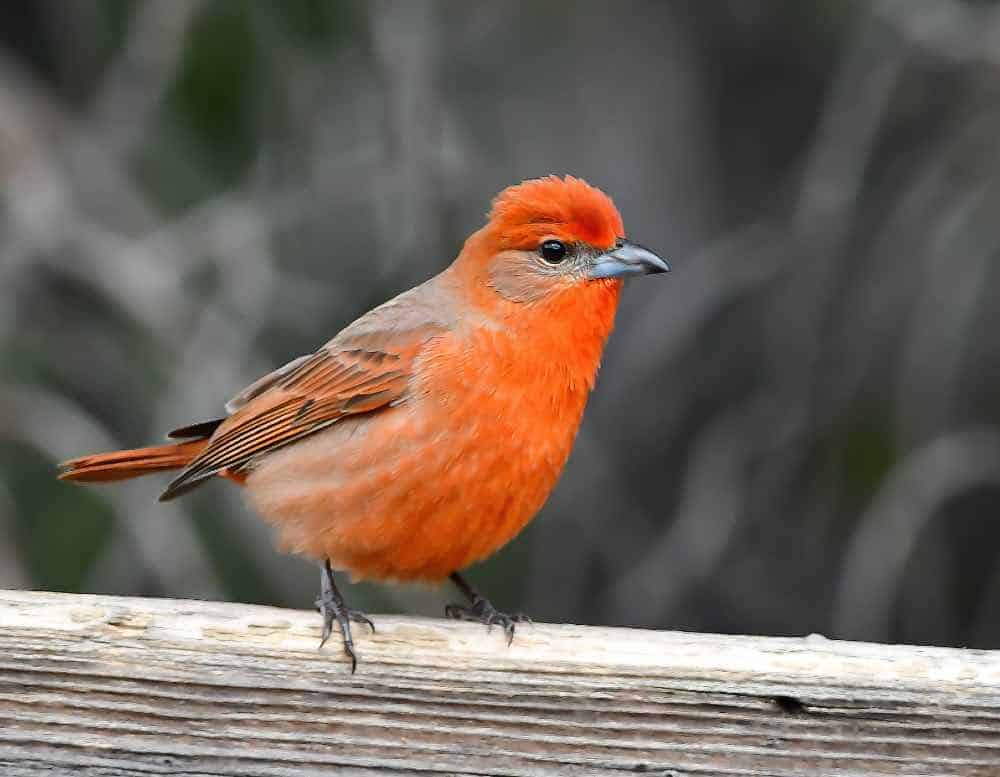
| Appearance | A small to a medium-sized bird that varies in size from 4 – 8″, dark red all over with streaks of gray, thick gray beak, and long tail. Female and juveniles are yellow. |
| Diet | Primarily insects and spiders. Also, dine on fruit. |
| Feeder Food | Do not commonly visit a feeder. |
| Habitat | Open wooded areas in a few southeast states |
| Nesting | Wide almost flat nest of grass, twigs, and other plant material. 1 brood/season, 3-5 eggs/brood. Eggs are blue/green with specs of brown/purple. |
Range Map
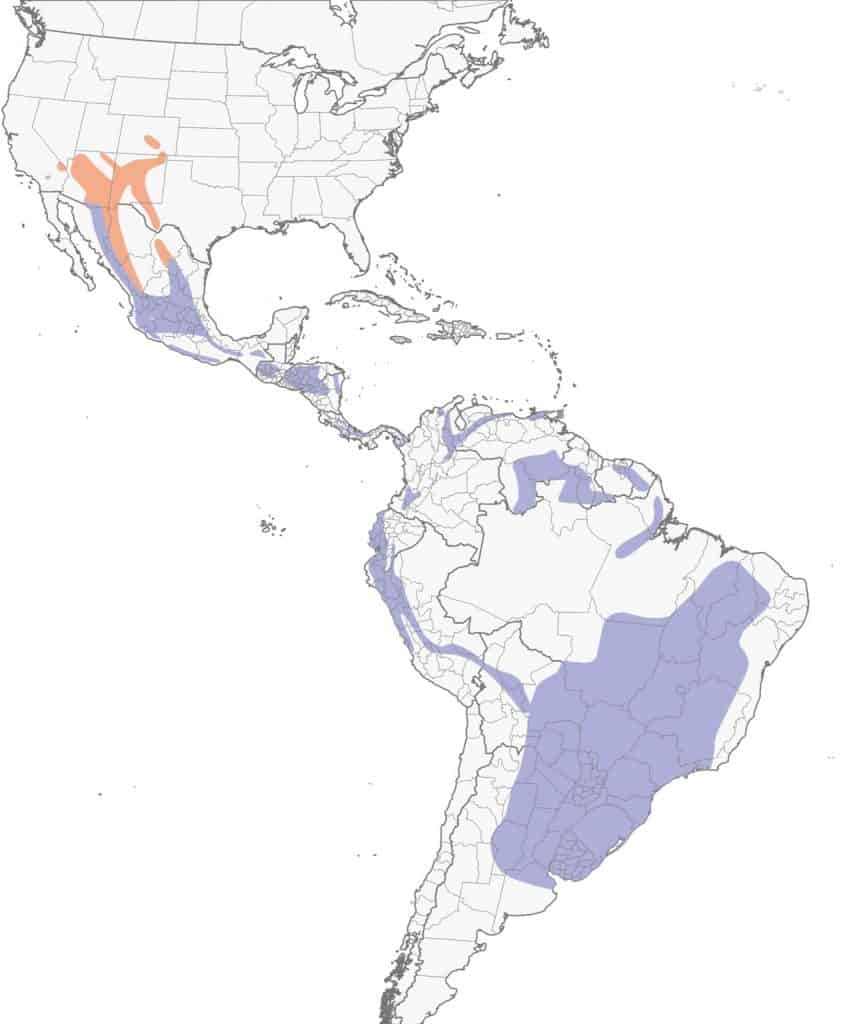
House Finch
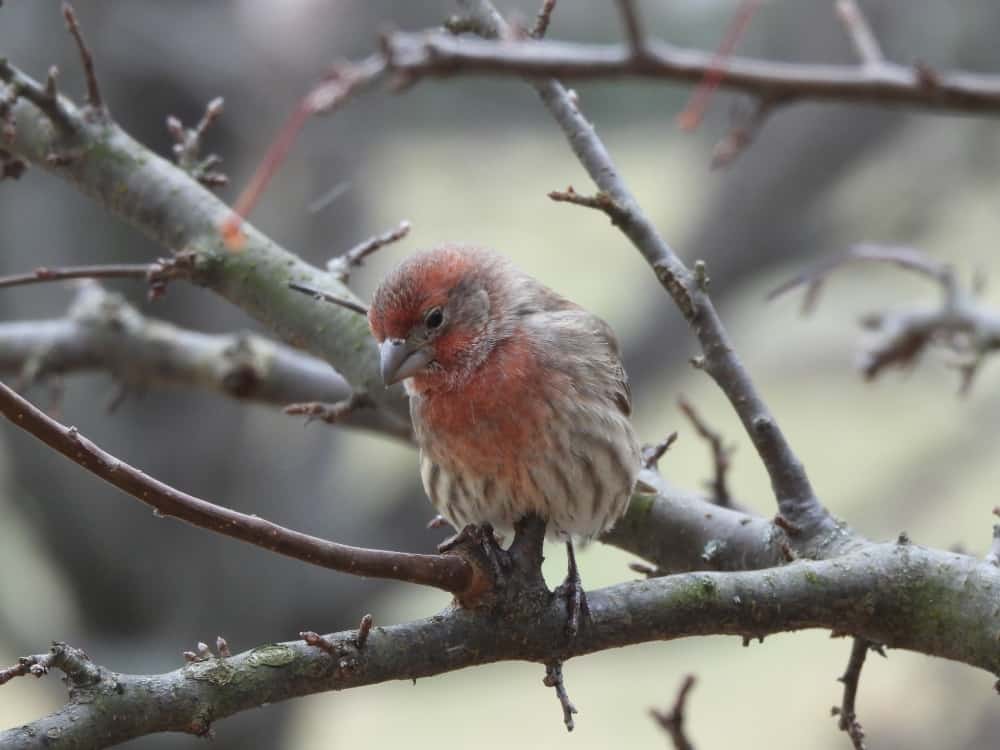
| Appearance | Small bird about 5″ long, orange/red face chest, and rump. Brown wings streaked with white. White belly with brown streaks. The Female and juvenile are brown with streaks of white. |
| Diet | Seeds, fruit, tree buds. |
| Feeder Food | Black oil sunflower seed is their favorite. |
| Habitat | House finches are found in the western and eastern parts of the US. They prefer to live around human dwellings (buildings, backyard trees, shrubs, barns. Also are found in parks and other urban areas. |
| Nesting | Nest: Small cup about 3-7″ wide, constructed from stems, leaves and plant roots, and feathers. The nests are built in coniferous or deciduous trees or even any place that holds a nest (ledges, vents, hanging plants). Broods: 1-6 broods/season Clutch: 2-6 eggs/brood (typical is 4-5) Egg color: Eggs are pale blue and speckled with black and purple dots. Egg size: 0.6 – 0.8 inches by 0.5 inches Incubation: 13-14 days and the young fledge between 12-19 days. |
| Migration | House finches are not migrators They remain in their year-round range for all seasons. Year-round range: Every US state except North & South Dakota, southern Ontario & British Columbia, and Mexico. |
Range Map
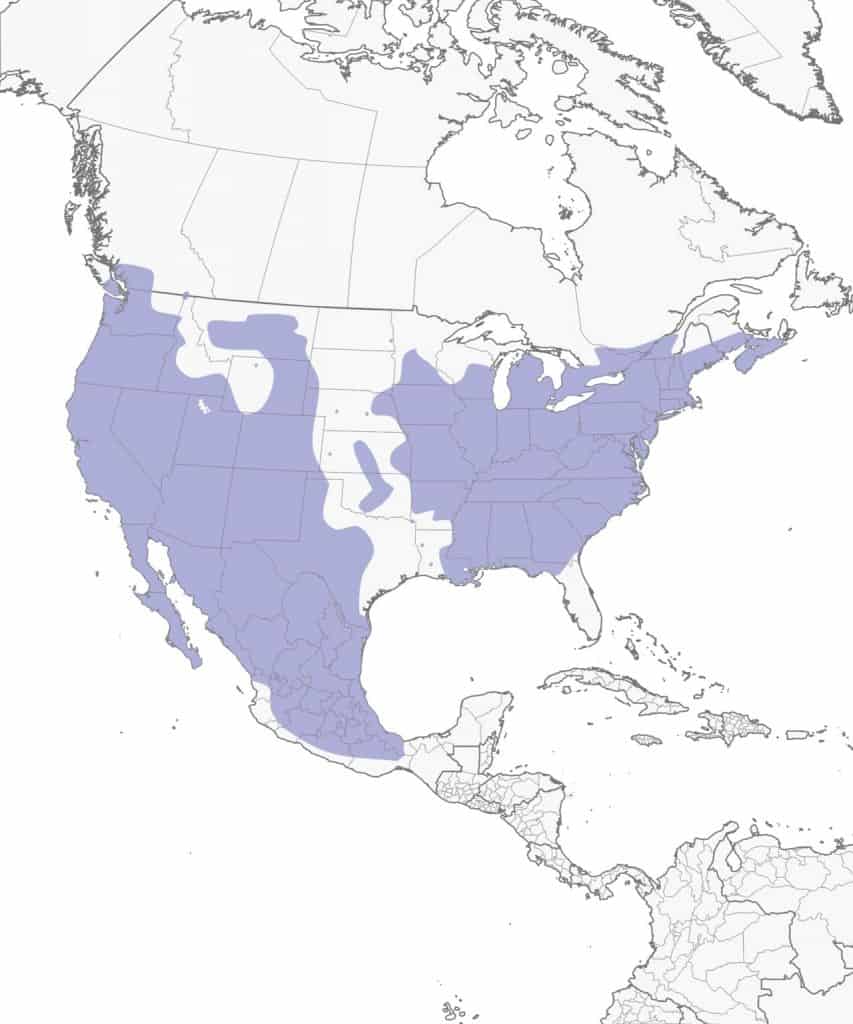
Pine Grosbeak
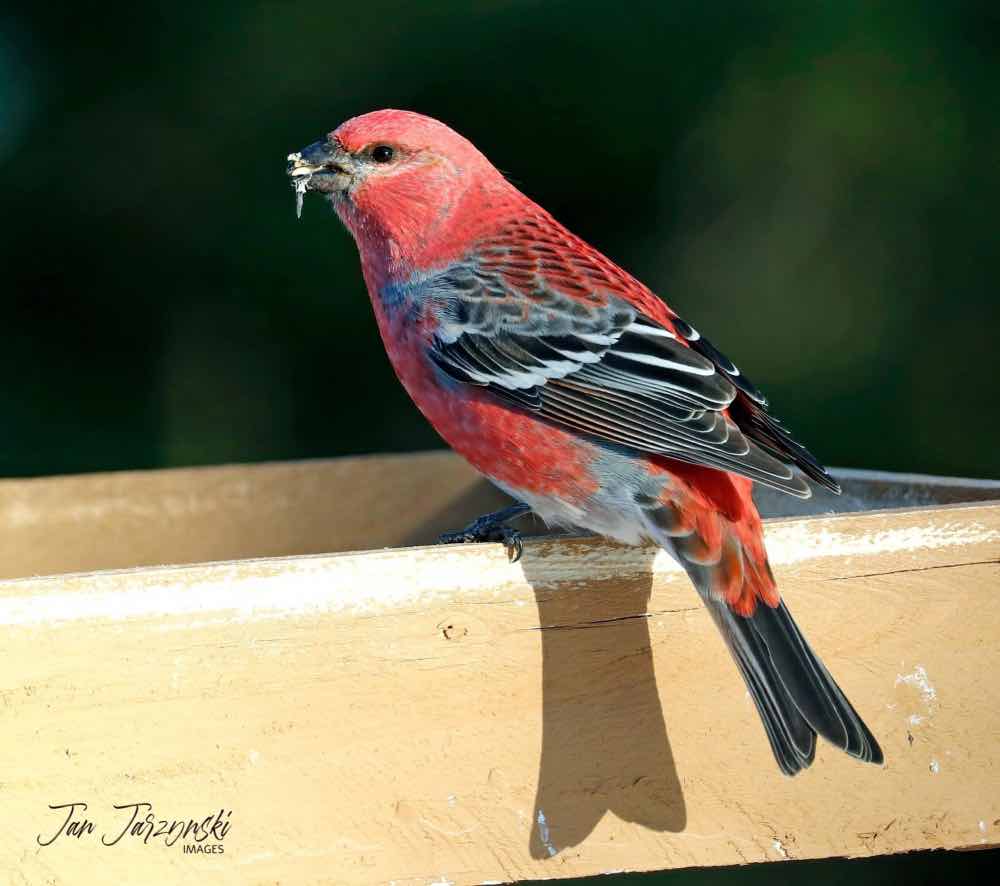
| Appearance | Sturdy bird approx 8-10″ long, soft pinkish-red with gray & charcoal body, short charcoal beak, medium tail with black tip, wings of black, white, and red. No crown. The Female is gray with a yellow head and tail. |
| Diet | Mostly seeds and fruits from their habitat (pine trees). Sometimes supplements with insects. |
| Feeder Food | Black-oil sunflower seeds and suet. |
| Habitat | Open areas with coniferous trees and deciduous trees in winter. |
| Nesting | About 20′ up in evergreen trees rests their rather large nest constructed with roots and twigs then lined grass, pine needles, and feathers. 1 brood/season, 3-4 eggs/brood, incubation lasts 13-14 days and they fledge between 13-20 days. Eggs are light blue and dotted. |
Range Map
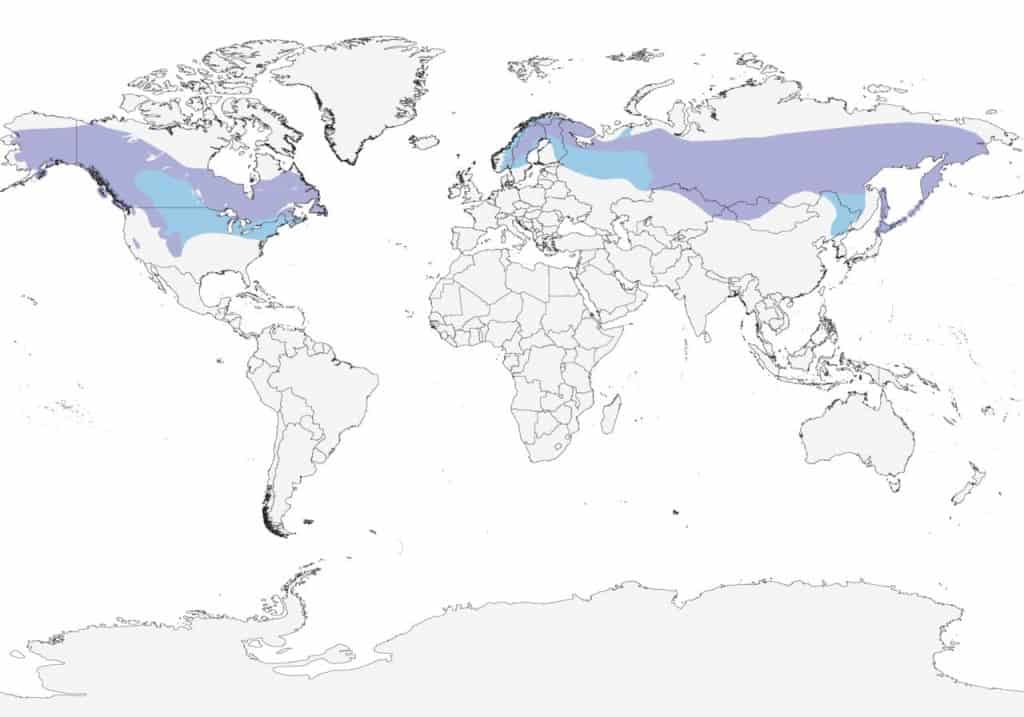
Purple Finch
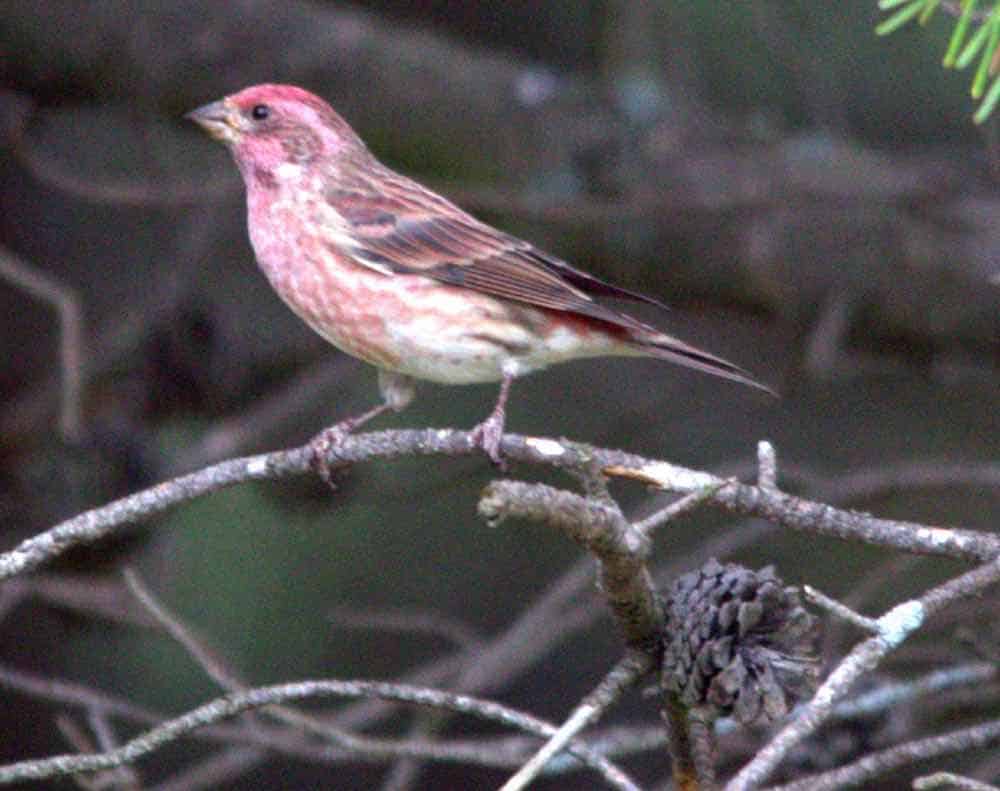
Appearance: Small bird about 6″ long with a raspberry-red head with lighter shades on the breast, back, and rump. The wings and tail are brown. Females are brown with brown striped breasts and white streaks across their eyes.
Diet: Seeds, insects, and fruit.
Feeder food: Black oil sunflower seeds are their favorite.
Habitat: Prefer coniferous forests in summer along with mixed forests near streams and tree-lined backyards.
Nesting: Purple finches’ nests are found anywhere from 2-60′ off the ground on a tree branch and constructed from twigs, sticks, and plant roots. Lined with grass and hair.
Migration: Purple finches are migrators. While many of them remain in their year-round range, others migrate north in the spring to breed and raise young. Then in the fall, the migrators head south for the winter.
Year-round range: The Pacific coast of Washington, Oregon, and California, and Canada’s British Columbia.
Breeding range: Just east of the year-round range along the Pacific northwest states and Canada’s provinces except for Nunavut.
Winter range: The eastern half of the US (except New England) and southern Arizona.
Range Map
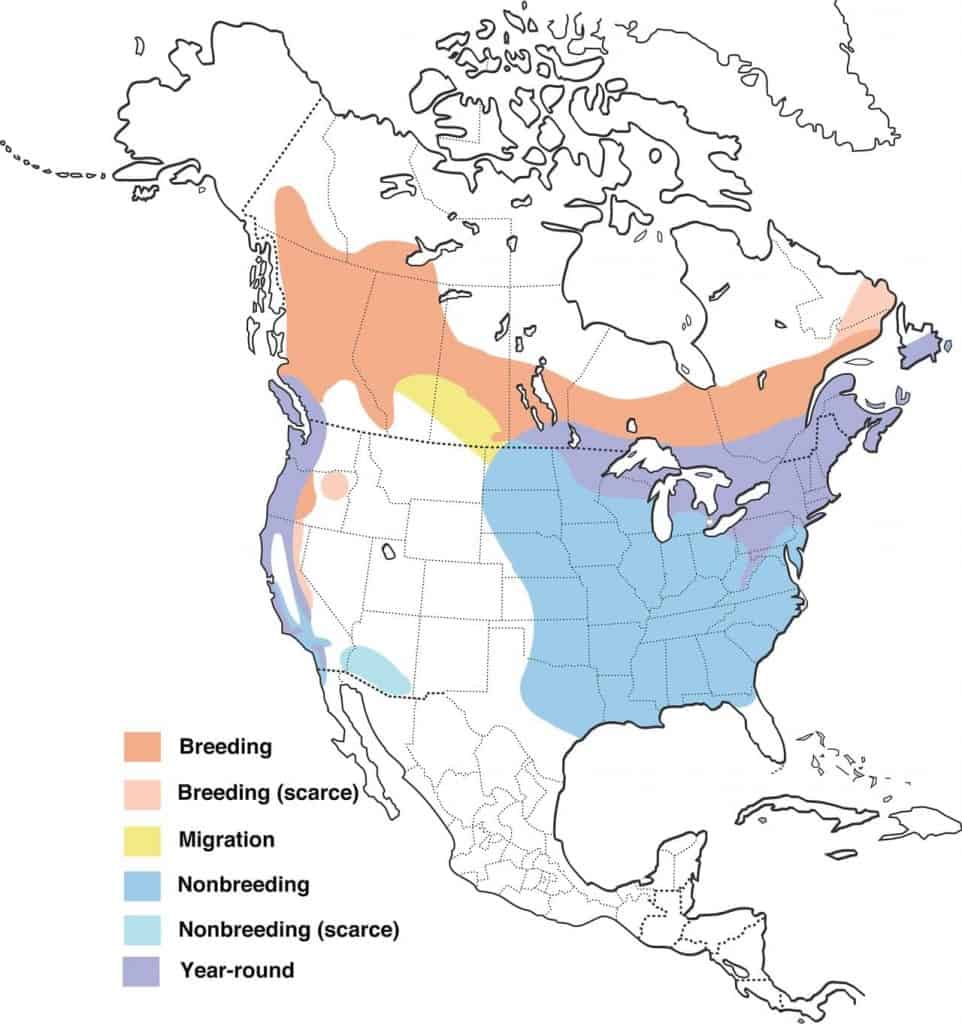
Red Crossbill
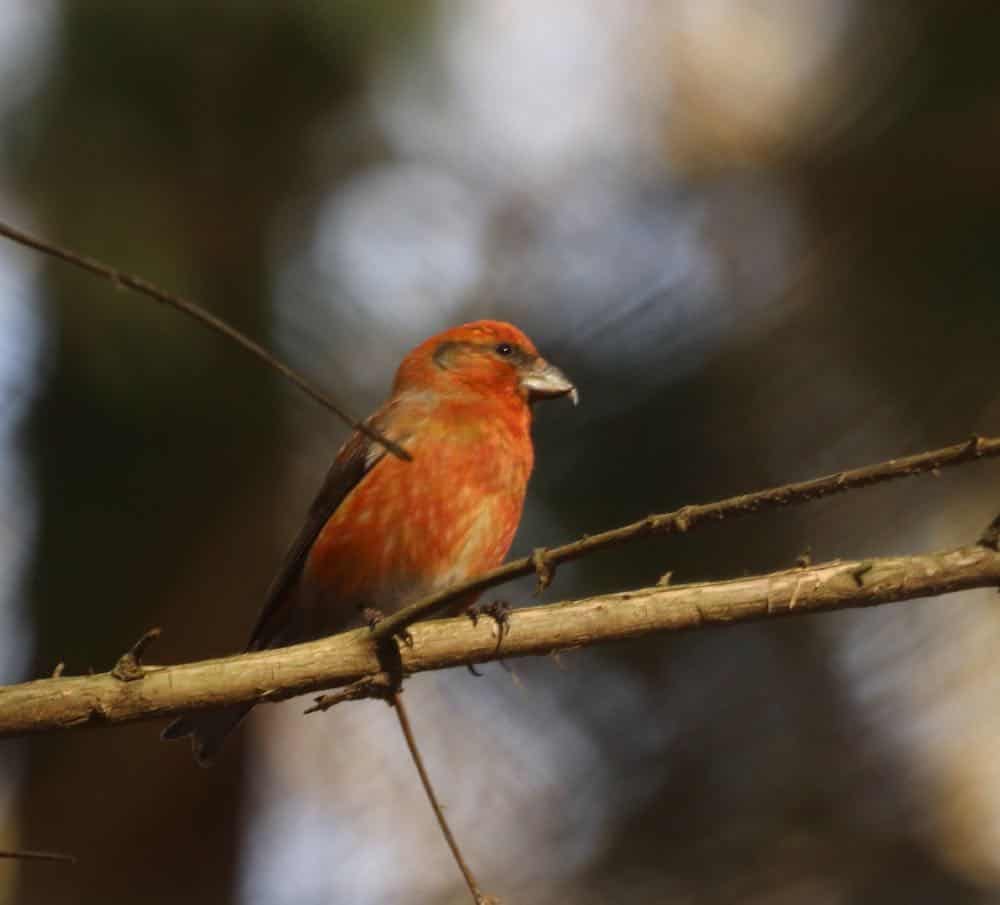
Appearance: The red crossbill is a small bird about 6.2″ long, dark red-orange with brown singes and tail. Their bill is long, pointed, and “crossed”. A brighter color of red on the head and rump. No crown. The female and young are pale yellow and gray.
Diet: Seeds – especially those inside pinecones. The bird’s “crossbill” is designed to pry open pinecones to get at the seed inside.
Feeder food: Black oil sunflower seed.
Habitat: Red crossbills either remain in their year-round territory for winter or expand south to create a wide winter range that includes Canada, the Pacific Northwest, states west of the Great Plains, Minnesota, Wisconsin, Michigan, New York, Vermont, Connecticut, and Massachusettes. They prefer mature coniferous forests.
Migration: While many red crossbills remain in their year-round range all seasons of the year, many migrate south for the winter.
Year-round range: The western half of the US, Mexico, and all Canadian provinces except Nunavut.
Winter range: Primarily northern Nevada, eastern Montana, North Dakota, South Dakota, northern Kansas, southern Minnesota & Wisconsin, northern Michigan, Pennsylvania, and New England. To a lesser degree, the remaining southern US states.
Range Map
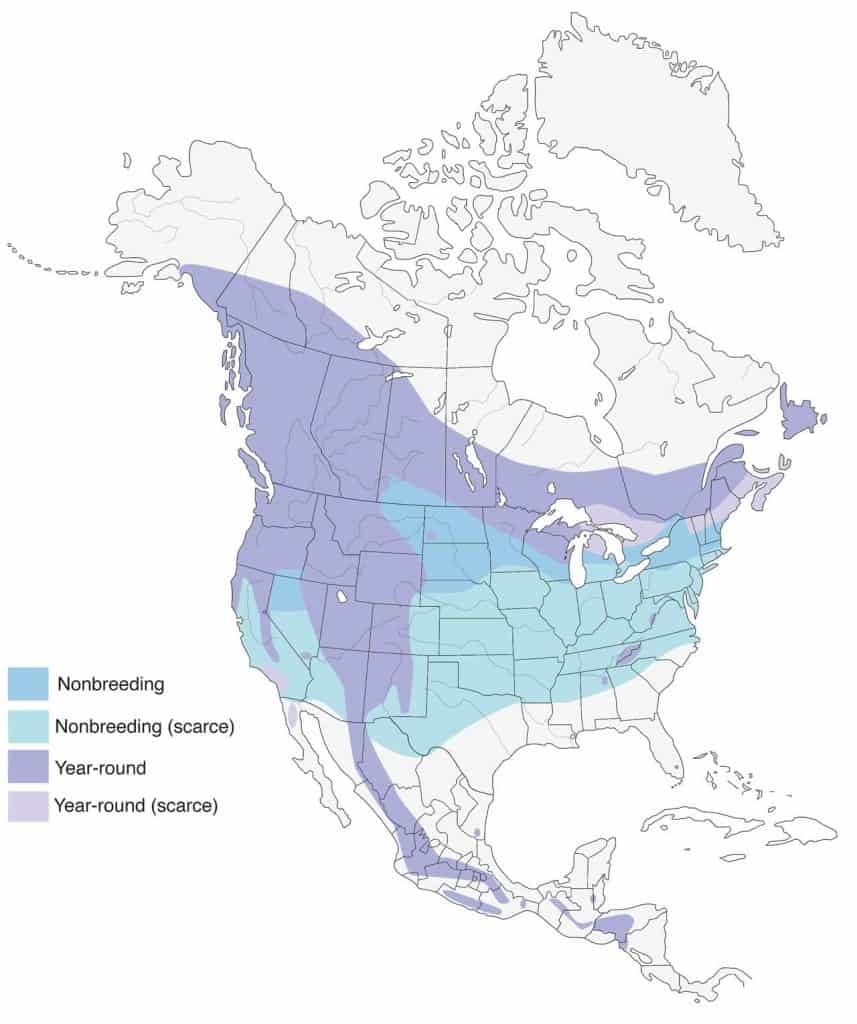
Scarlet Tanager
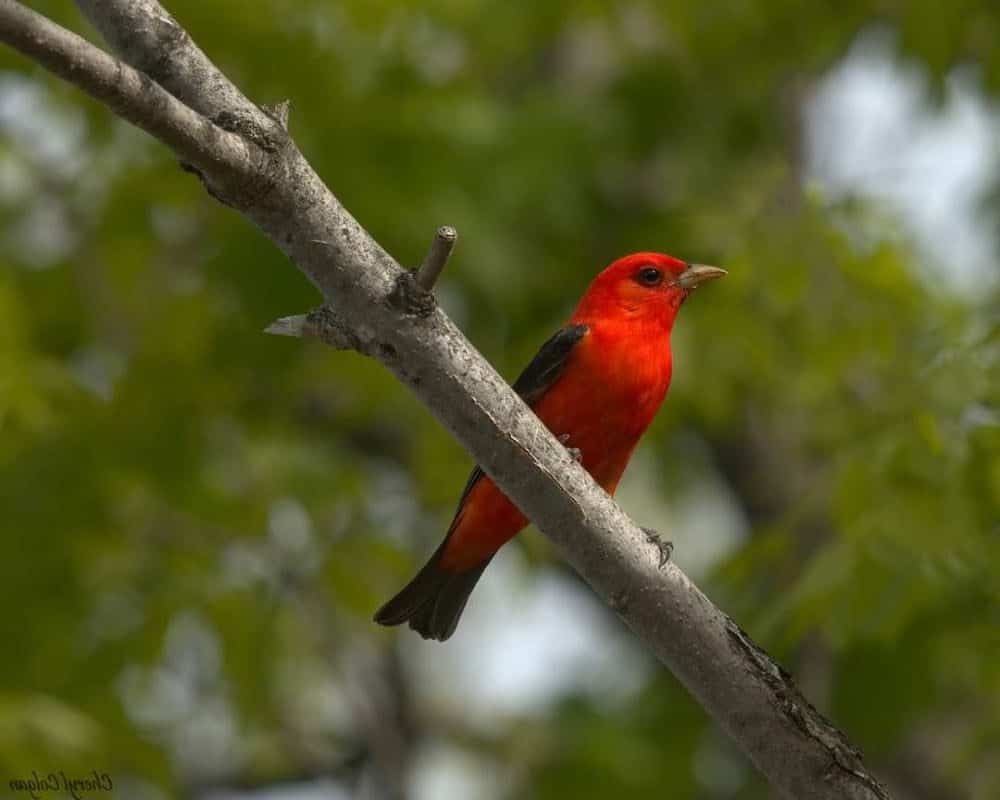
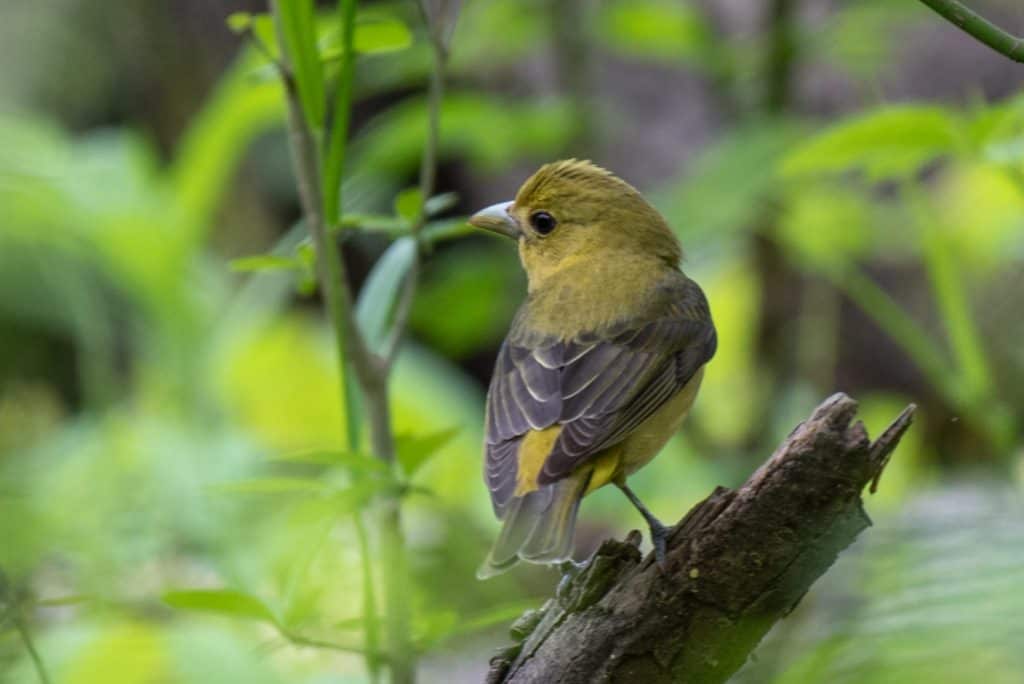
Appearance: Scarlet tanagers are small birds about 6.5″ long, with vibrant red faces and bodies (although many consider them to be a deep shade of orange), tan beaks, black wings, and short black tails. No crown. The female scarlet tanager (and juveniles) are the same except yellow instead of red.
Diet: Insects in summer; fruit in fall/winter.
Feeder food: Scarlet tanagers are unlikely to visit feeders. However, you can attract them by planting berry-producing plants such as blackberries, raspberries, huckleberries, juneberries, serviceberries, mulberries, and strawberries.
Habitat: Thickly forested regions in the eastern US. Often spotted high in the treetops.
Nesting: A loosely constructed nest of grass, twigs, bark strips, pine needs, and other plant materials. The nest rests high in a deciduous tree out in the middle of a horizontal branch about 50′ up. 1 brood/season, 3-5 eggs/brood, eggs are green/blue with multicolored and shaded marks of brown, purple/red. Incubation is 12-14 days and the young fledge is between 9-15 days.
Migration: Scarlet tanagers are migrators. In the spring, they migrate north to breed and raise their young. In the fall, they migrate south for the winter.
Breeding range: Primarily the eastern half of the US (except Florida and Louisiana), as well as the southern part of Canada’s Manitoba, Saskatchewan, and Ontario.
Winter range: South America.
Range Map
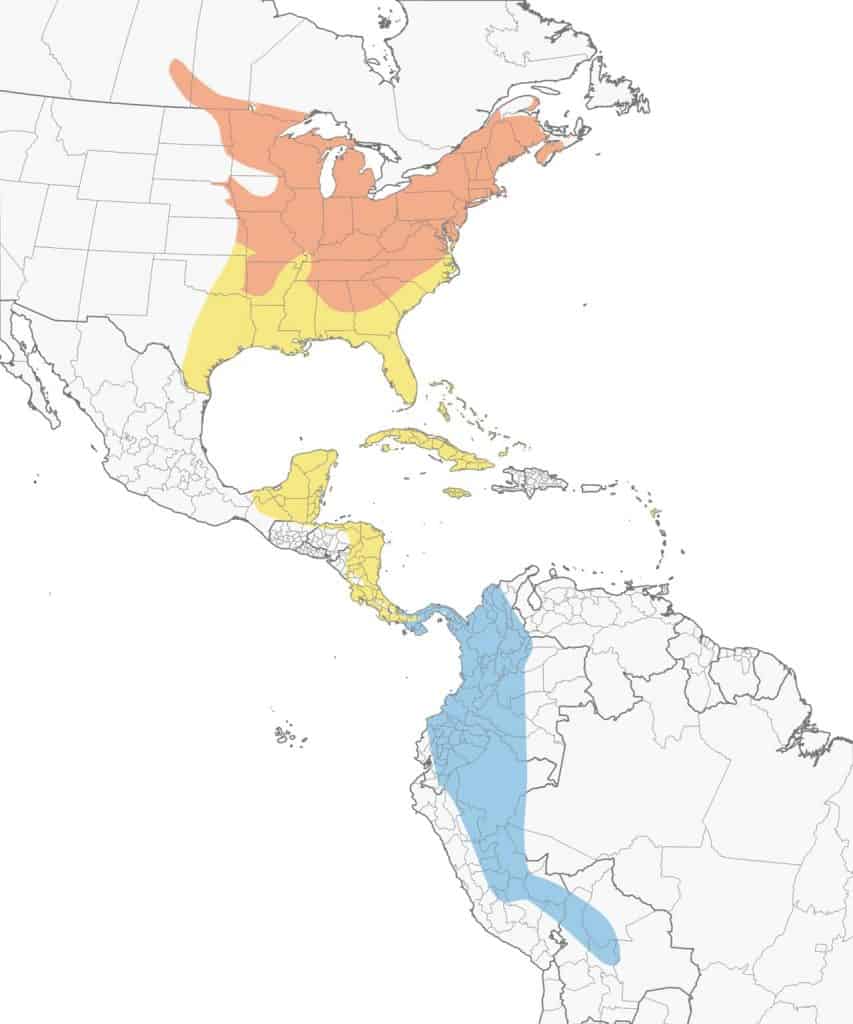
Summer Tanager
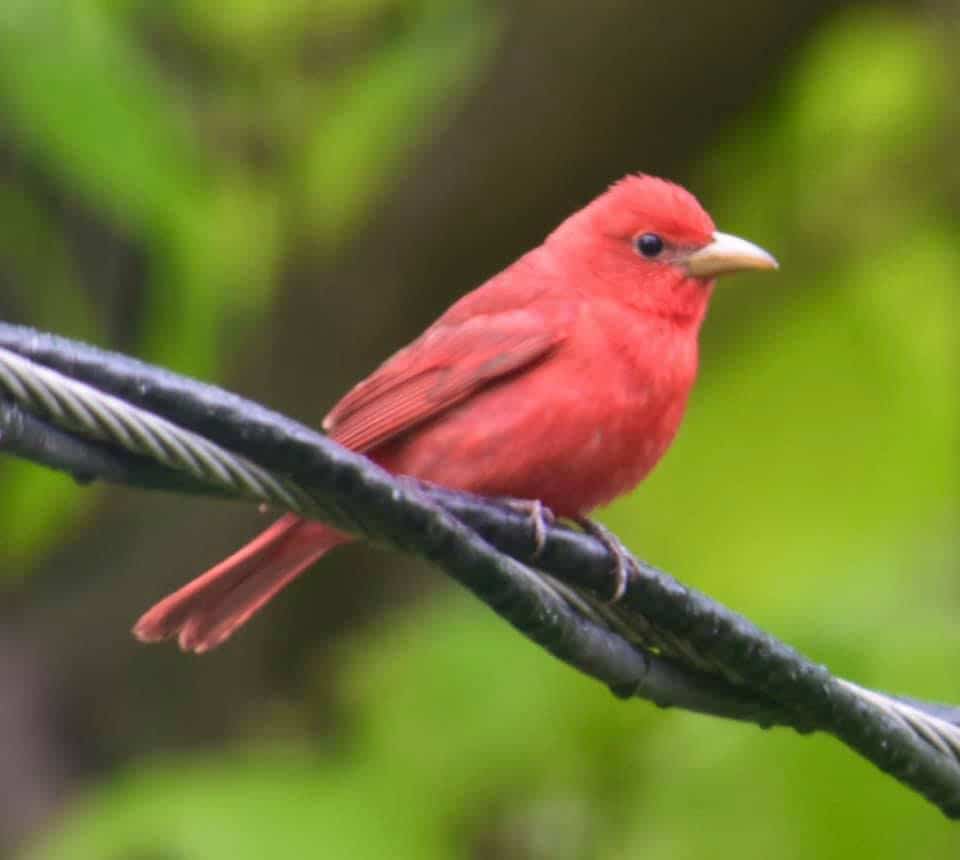
Appearance: The summer tanager is a small bird about 6.5-7″ long, with bright red all over, a long tan beak, a medium-length tail, and no crown. Female and juvenile are yellow.
Diet: Insects, especially bees and wasps. Also dine on spiders, cicadas, beetles, ants, and termites. Fruit including mulberries, pokeweed, citrus, and bananas.
Feeder food: Unlikely to visit a feeder. However, they can be enticed by planting berry trees and shrubs – especially near a forested area.
Habitat: Open forested areas that contain deciduous & pine trees throughout much of south-central and southeastern US.
Nesting: The nest is constructed primarily from dried grasses and herbs into a small cavity and often placed at the fork of tree branches. 1-2 broods/season, 3-4 eggs/brood, incubation is 11-12 days and the young fledge after about 8-12 days. Eggs are pale blue/green with brown spots.
Migration: Summer tanagers are migrators. In the spring they migrate north to breed and raise their young. Then in the fall, they migrate back south for the winter.
Breeding range: Midwest and southern US states including California, Nevada, Arizona, New Mexico, Texas, Oklahoma, Kansas, Iowa, Missouri, Nebraska, Louisiana, Illinois, Indiana, Ohio, Kentucky, Tennessee, Mississippi, Georgia, Alabama, Florida, South Carolina, North Carolina, Virginia, and Pennsylvania.
Winter range: Mexico, the Caribbean islands, Central America, and South America.
Range Map
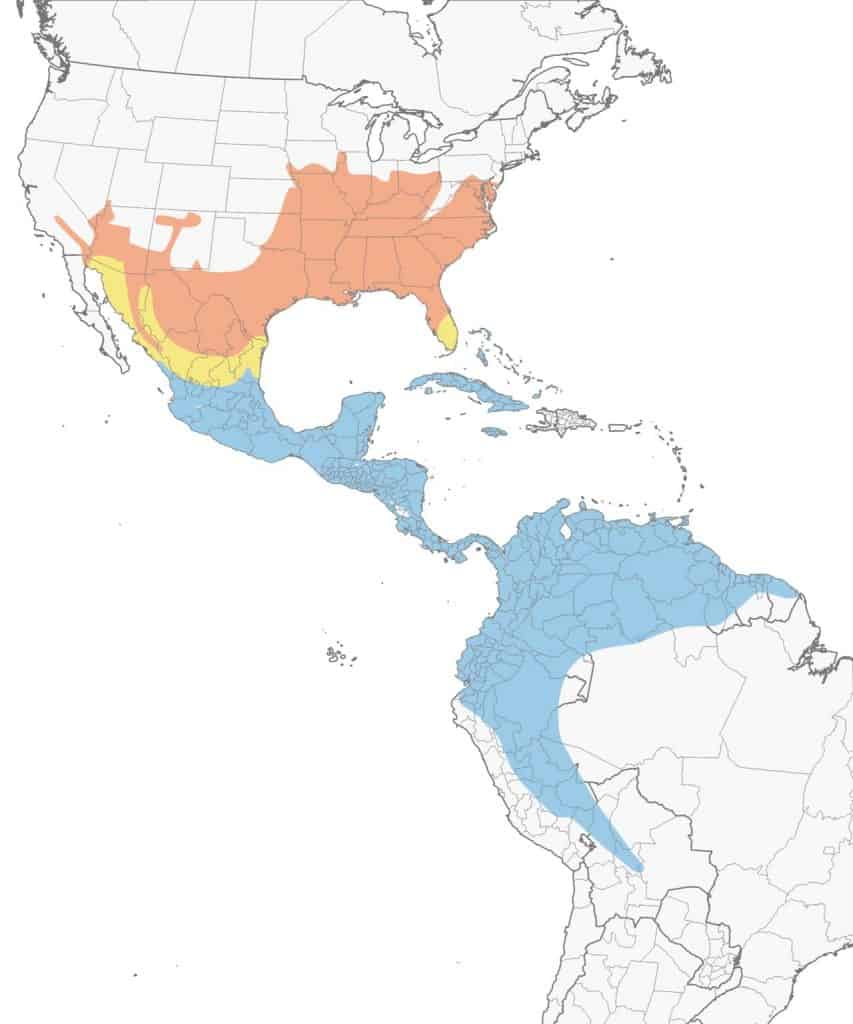
Vermilion Flycatcher
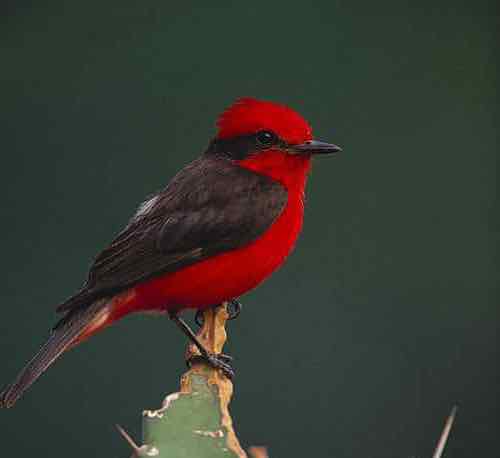
| Appearance | Small bird about 5″ long. Bright red-orange with brown back, feathers, tail, and a mask over each eye. Flathead and stocky chest with a dark brown pointy bill. Females are gray/brown with a white breast and rust-colored lower belly. |
| Diet | Flying insects are their favorite. They also dine on grasshoppers and butterflies, honeybees, beetles, and crickets. |
| Feeder Food | You may be able to entice them with mealworms. |
| Habitat | Primarily live in the far southwest in the scrubby desert, wooded areas near riverbanks and lowlands with shrubs. |
| Nesting | Small nest constructed of twigs, grass, and spiderwebs located about 10-20′ up in a tree in the fork of a branch. 1-2 broods/season, 2-4 eggs/brood, incubation is 13-15 days and the young fledge about 14-16 days. Eggs are white with light and dark spots. |
Range Map
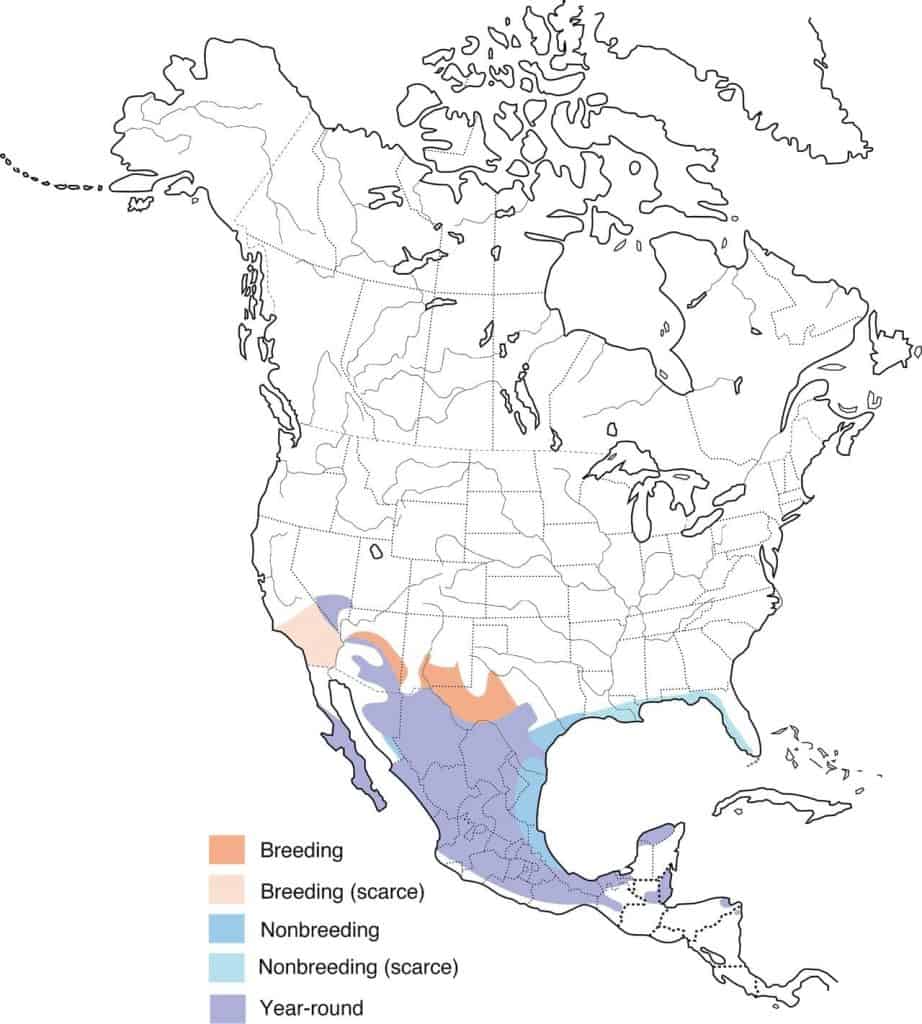
Difference between a Red Bird and a cardinal
Male cardinals are perhaps the most recognizable red bird throughout the US and Canada. The vibrant red color throughout its body is breathtaking.
There are 3 key differences between other red birds and the cardinal: the crown, the beak, and the body size.
- The male cardinal is the only red bird with a prominent red crown on the top of its head. On occasion, the crown will lay back but it’s typically standing tall clearly identifying the red bird as the cardinal.
- The male cardinal is the only red bird with a bright orange beak.
- The male cardinal is the only medium-sized red bird whereas the other red birds are several inches smaller. The only exception is the Pine Grosbeak which is about the same size as the male cardinal – about 9″.
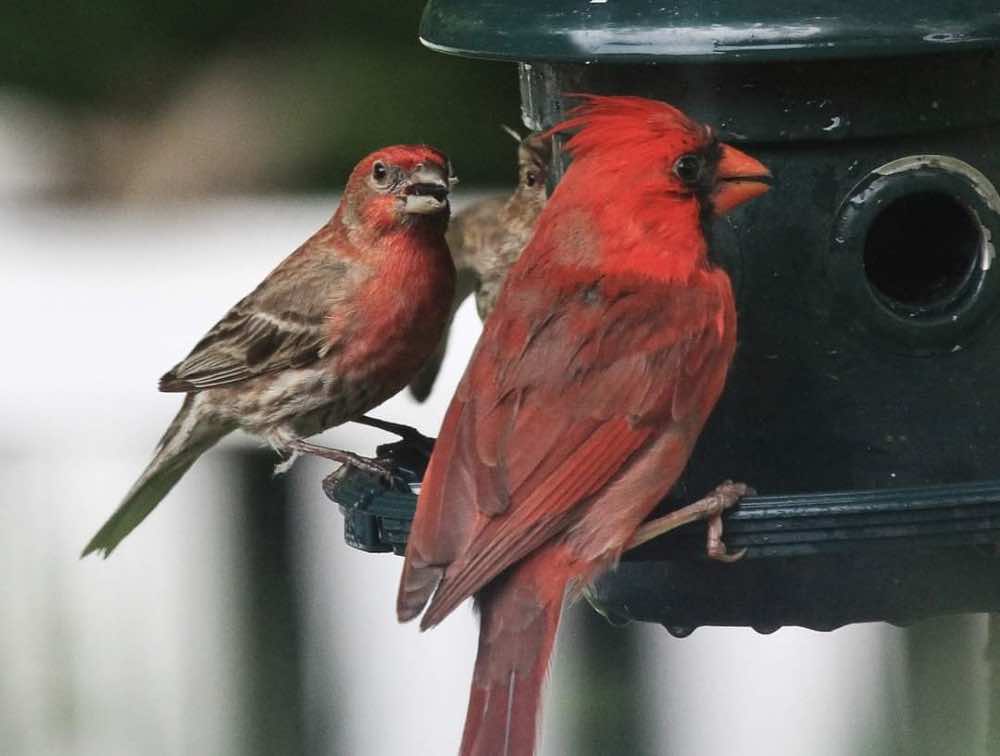
The biggest difference between a male cardinal and some of the red birds on this list is the crown. Only the male cardinal is an all-red bird with a tall and majestic crown. The cardinal’s beak is another dead giveaway. It’s the only red bird with a vibrant orange beak.
If you’re interested in learning more about cardinals check out my comprehensive article How to Attract Cardinals.
Are red birds rare?
None of the small red birds included in this article are rare. They are all common within the range in which they live.
I hope you’ve identified your small red bird. If so, please comment below on what bird you identified and your location. If you weren’t able to identify the small red bird you saw, comment below what characteristics the bird had that were missing from the list above.
Happy Birding!

